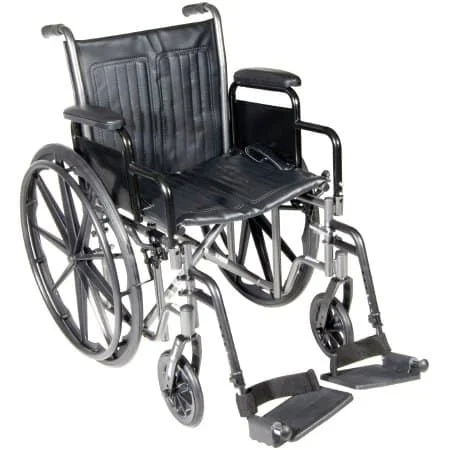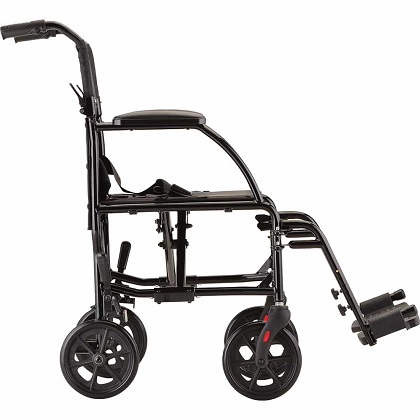When choosing a wheelchair, one size doesn't fit all. A bariatric wheelchair, specifically designed for individuals with larger body sizes, requires careful consideration to ensure comfort and mobility. This comprehensive guide will explore the essential aspects of bariatric wheelchair width and sizing, breaking down the complexities into simple terms.
Bariatric Wheelchair Width for a Proper Fit
Wheelchair sizing is crucial because it directly impacts your comfort, mobility, and overall quality of life. A wheelchair that's too narrow can feel cramped and uncomfortable and may lead to pressure sores. On the other hand, a wheelchair that's too wide can be challenging to maneuver through tight spaces, hindering your independence and convenience.
Bariatric wheelchairs are made for larger people who need a strong and stable chair. They are more comprehensive than regular wheelchairs, usually 16 to 20 inches wide. Bariatric wheelchairs start at 22 inches wide and can be wider, up to 30 inches or more.
To pick the right bariatric wheelchair size, you should measure yourself and consider your comfort. If your hips are between 22 and 24 inches wide, a 22-inch-wide chair might be good for you. If your hips are between 25 and 28 inches wide, a 24-inch-wide chair could be better. If your hips are wider than 28 inches, you might need a chair that's 26 inches wide or more. Remember, these are just general suggestions, and your needs might differ. It's always a good idea to talk to a healthcare expert or wheelchair specialist for personalized advice.
Measuring for the Right Fit for Your Bariatric Wheelchair
Before delving into the details of bariatric wheelchair sizing, let's start with the basics: measuring for the right fit. Seat width refers to the distance between the armrests. To determine the appropriate seat width, measure the widest part of your hips and add a few inches for comfort. Remember that your seating needs can change over time, so it's essential to consider any potential weight fluctuations or changes in your condition.
Seat depth is the distance from the backrest to the front of the seat cushion. To measure your ideal seat depth, sit comfortably against a wall and measure the distance from your lower back to the back of your knees. Make sure to leave a couple of inches for clearance. The backrest height is the distance from the seat to the top of the backrest. Consider your upper body's support needs to determine the right backrest height. A taller backrest can provide more upper-body support and stability.
Armrest height affects your comfort and ease of transferring in and out of the wheelchair. Measure from the seat to your elbow when your arms are at a 90-degree angle to determine the appropriate armrest height. If your wheelchair has adjustable footrests, ensure they are long enough to support your legs comfortably without putting pressure on your thighs or calves.
Maneuverability and Accessibility Options
When you pick a big wheelchair for bigger folks, ensure it fits your butt comfortably. But also think about how easy it is to move around in different places. If you use your wheelchair mostly inside your house, consider how wide your doors and hallways are. Ensure your wheelchair can go through them without getting stuck or breaking things.
If you want to use it outside a lot, a slightly wider wheelchair can be better because it won't tip over as quickly, and you'll have a smoother ride. But be careful on narrow paths or when many people are on the sidewalk. If you must put your wheelchair in a car, ensure it fits inside. Some oversized wheelchairs are heavy, so your vehicle might need a particular lift or ramp.
How to Consider Your Weight Capacity
In addition to seat width, it's crucial to consider the weight capacity of your bariatric wheelchair. Weight capacity refers to the maximum weight the wheelchair can safely support. Bariatric wheelchairs typically have higher weight capacities than standard wheelchairs, ranging from 300 to 700 pounds.
Ensure that the wheelchair's weight capacity comfortably exceeds your current weight to provide a margin of safety. Also, consider any potential weight changes or additions, such as backpacks or accessories, when assessing the wheelchair's weight capacity.
How to Choose the Right Material
Bariatric wheelchairs are constructed from various materials, each with benefits and considerations. The two primary materials used for wheelchair frames are steel and aluminum. Steel frames are robust and durable, making them suitable for individuals with higher weight capacities. However, they tend to be heavier and may require more effort to propel.
Aluminum frames are lighter, making them easier to maneuver. They are a good choice if you plan to transport your wheelchair frequently. However, they may have lower weight capacities compared to steel frames. Your choice of material depends on your specific needs and priorities. If you value lightweight maneuverability, aluminum may be the way to go. Steel might be a better option if durability and a higher weight capacity are your top concerns.
Final Thoughts on Choosing the Width and Sizing
Selecting the correct bariatric wheelchair width and size is a significant decision that can significantly impact your daily life. By measuring correctly, considering your mobility needs, and seeking expert guidance, you can ensure that your wheelchair provides the comfort, stability, and independence you deserve. Remember that your wheelchair should adapt to your needs, not vice versa, so take the time to find the perfect fit.